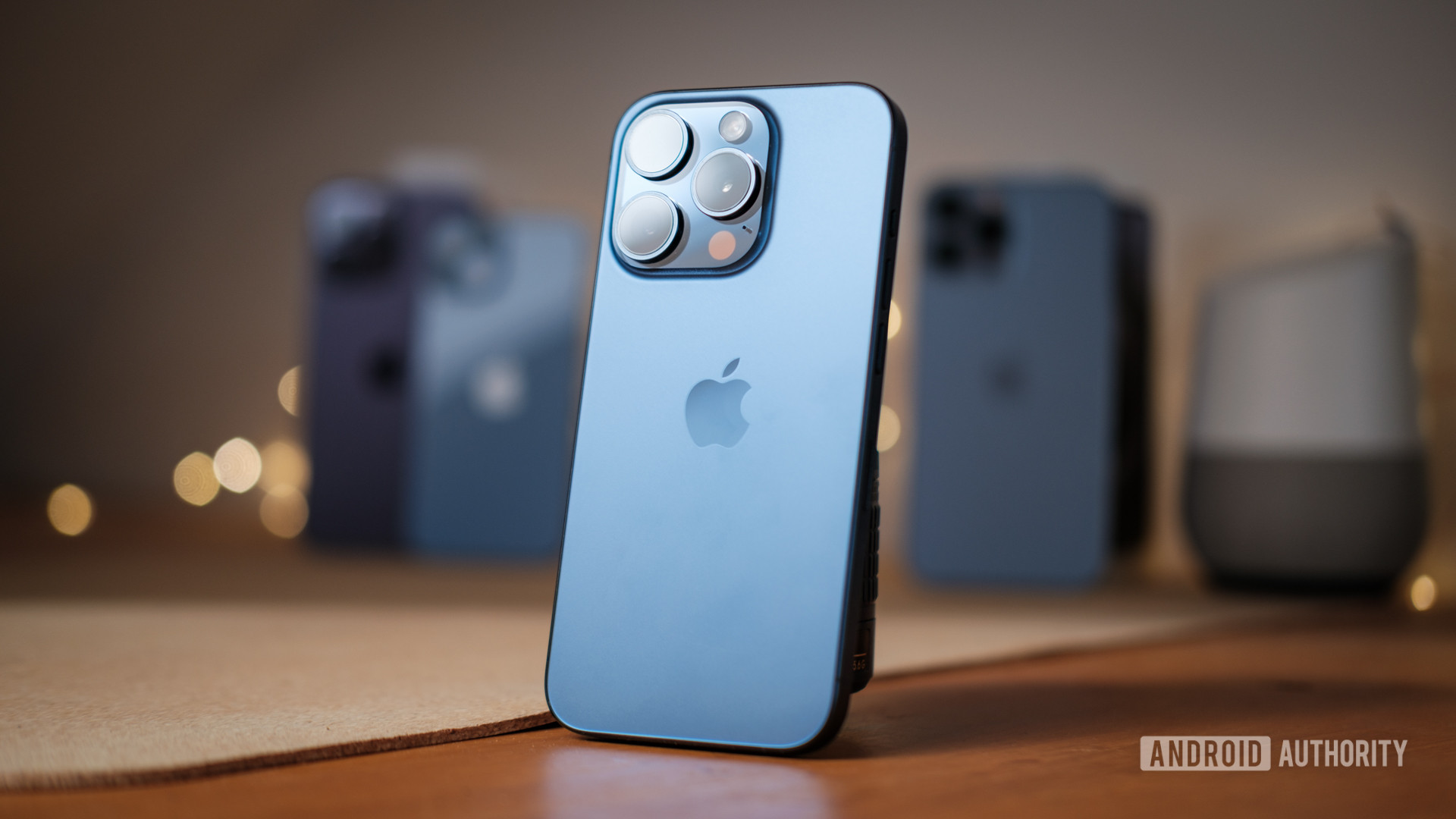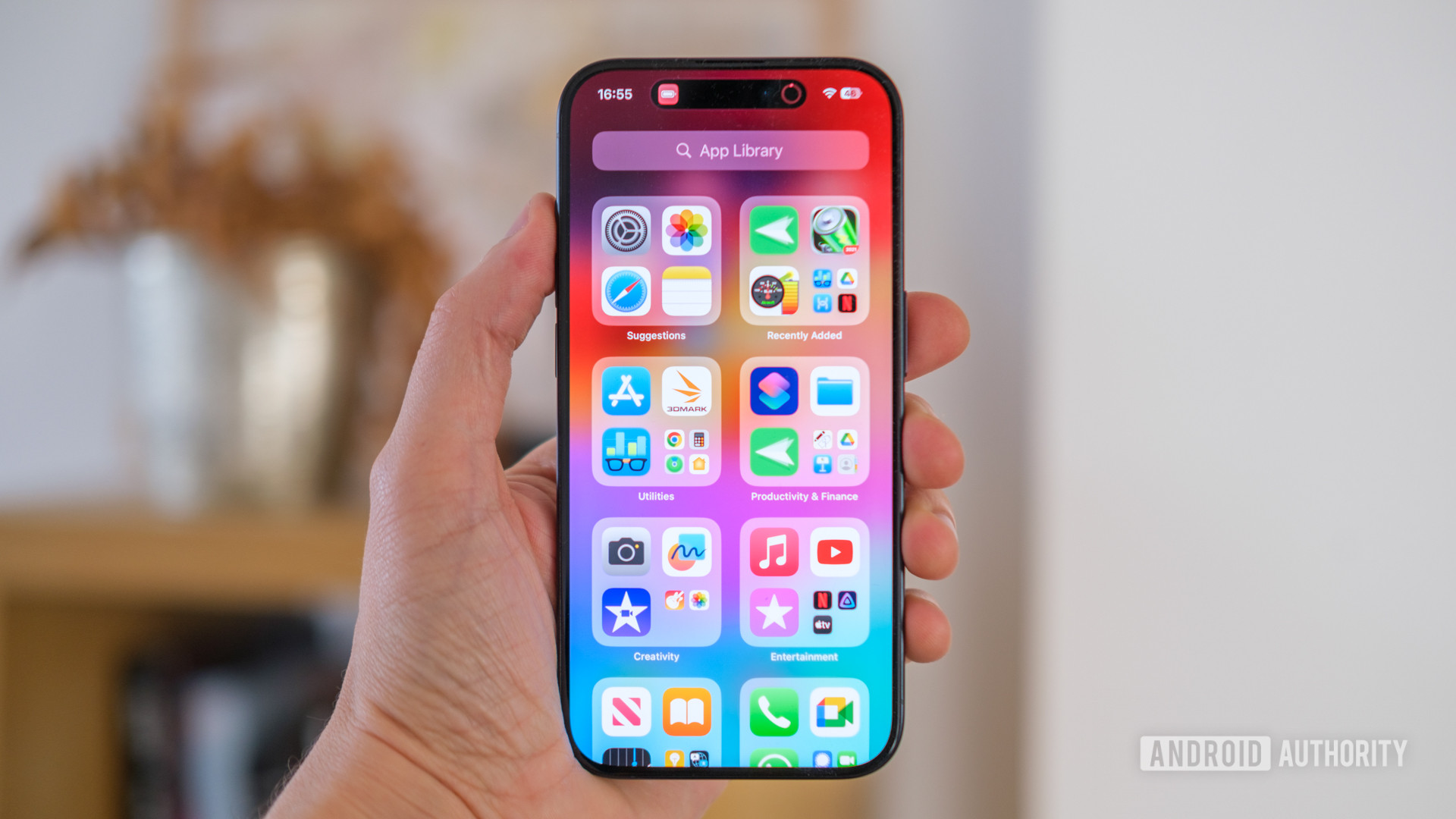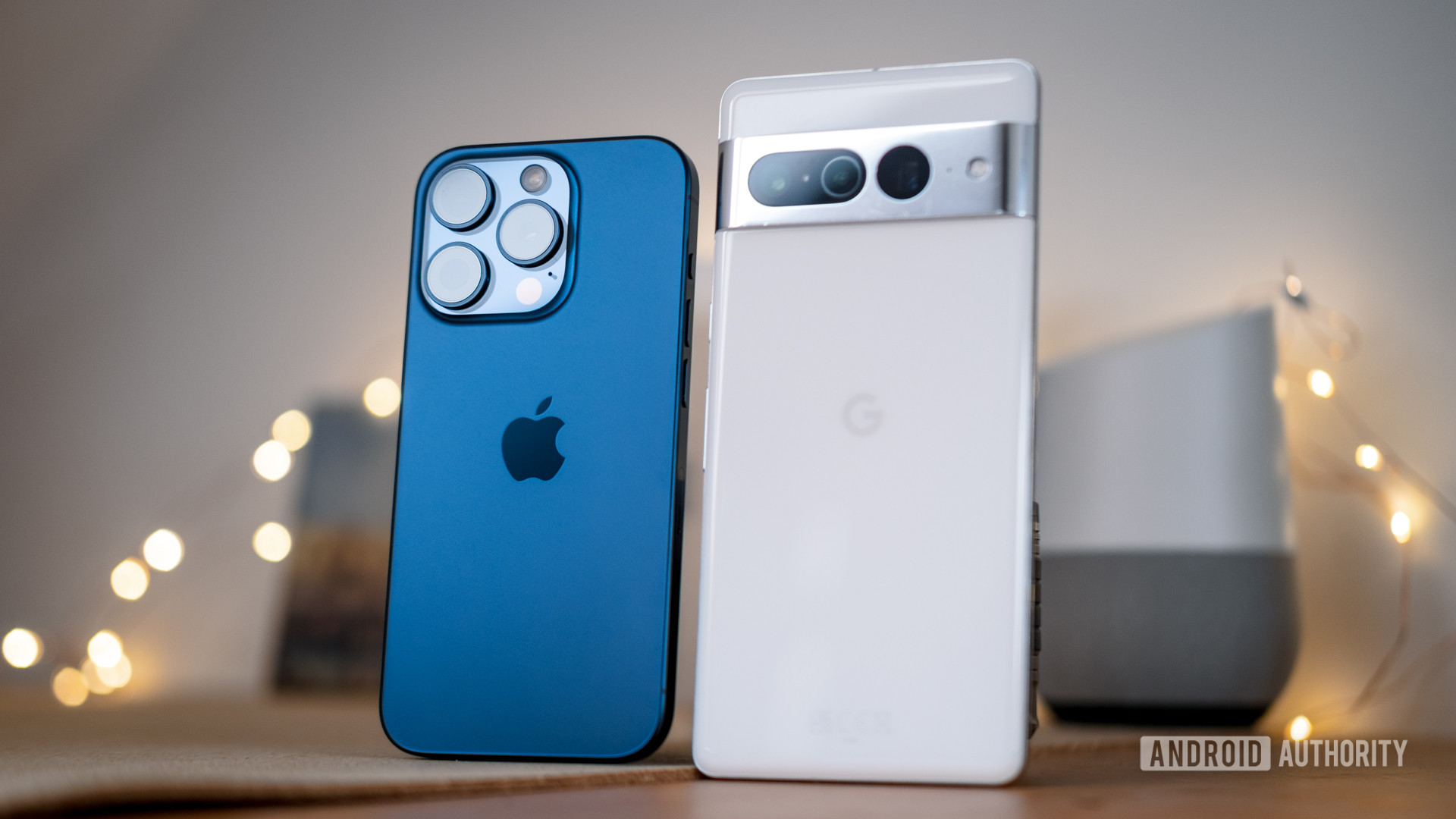Affiliate links on Android Authority may earn us a commission. Learn more.


iPhone 15 Pro review: Is Apple's flagship Android alternative worth buying?
Published onJanuary 17, 2024

Apple iPhone 15 Pro
MSRP: $999.00
What we like
What we don't like

Apple iPhone 15 Pro
Apple iPhone 15 Pro review: At a glance
- What is it? The iPhone 15 Pro is the smaller sibling to the gargantuan iPhone 15 Pro Max. Compressing Apple's best mobile technology, including flagship processor and camera capabilities, into a more compact form factor is no mean feat, and the iPhone 15 Pro is the Cupertino company's leading Android alternative.
- What is the price? The iPhone 15 Pro starts at $999 for the 128GB model and costs up to $1,499 for 1TB of storage.
- Where can you buy it? iPhone 15 Pro pre-orders started on September 15 and began shipping on September 22. The phone is available directly from Apple and all major carriers.
- How did we test it? I tested the Apple iPhone 15 Pro for five days. The review unit was purchased by Android Authority.
- Is it worth it? You'll find a few interesting additions to the iPhone 15 Pro, like the Action Button and USB-C connectivity. However, they don't move the needle much when lingering annoyances, like slow charging, remain unaddressed. The iPhone 15 Pro is a fine upgrade from an aging model but not one to rush out and buy, especially when Android offers many impressive alternatives.
Update, January 2024: We’ve updated our iPhone 15 Pro review with details about new Android alternatives.
Should you buy the Apple iPhone 15 Pro?

Let’s jump into the two significant changes to an otherwise overfamiliar iPhone design. First, the USB-C port (good riddance Lightning). Finally, we can charge the iPhone 15 series with the same plugs and cables all your other modern gadgets use. The Pro model also boasts fast 10Gbps data speeds over the port, making data transfer much quicker than with Lightning, and DisplayPort for external display mirroring. These benefits are familiar to the Android crowd but propel Apple’s formula into the modern era. However, you’ll have to buy a better USB-C cable than the one Apple supplies to benefit — a cheap decision for a $1,000 purchase.
The second significant addition is the Action Button, and it’s pretty great. I’ve loved mappable buttons and gestures on the occasional Android phone, and in classic Apple form, the iPhone 15 Pro takes an established feature and adds a layer of polish. However, you have to master Shortcuts to make the most of it, such as presenting a menu of options that extend the button’s initial limited functionality. The default Silent, Focus, Camera, Magnifier, Torch, and Accessibility quick access are fine, but why settle for one option when you can have many?
The iPhone 15 Pro is IP68 rated for dust and water resistance.
Apple has also swapped out the chassis for Titanium this year, making the phone 19 grams lighter than its predecessor. I welcome this change, but I feel that the iPhone 15 Pro remains too weighty in the hand. With the same display and camera housing layout, the 15 Pro is tough to tell apart from its predecessors, and the slightly revamped colorways don’t rejuvenate any “new toy” excitement either. While the hardware tweaks are all well implemented, this is fundamentally the same iPhone we already know intimately. Any amount of flair will need to be provided by a colorful case.
Probably not, but it depends on the case. The two phones have similar dimensions, but the iPhone 15 Pro is a few millimeters slimmer, so it’s doubtful that old cases will fit correctly.
iOS 17 brings additional changes, but the core iPhone experience remains faithful to the working formula, and these new features aren’t exclusive to the iPhone 15 series. Some of the more noteworthy additions are FaceTime video messages and reactions, improved autocorrect thanks to a new machine learning model, interactive home screen widgets, the new StandBy lock screen, live voicemail transcriptions, and contact posters — all solid additions.
Action Button and USB-C breathe some new life into an otherwise familiar iPhone.
Now, if you’re eyeballing the iPhone 15 Pro for peak performance, you won’t be disappointed. Apple’s latest A17 Pro chip tops our benchmark table by a notable margin; the phone is frankly overkill for messaging and browsing the web. But the reason to buy a Pro model is to put that extra horsepower to work multitasking, gaming, and multimedia editing, and the phone certainly excels here.
That said, all this performance comes with a price — high temperatures. First, our stress test results are disappointing for serious gamers. The iPhone 15 Pro gives up its peak performance after just a single run of 3DMark’s various stress tests. While more demanding than most high-end titles, this indicates that the phone risks high temperatures and performance throttling during longer play sessions and when playing games that use ray tracing. Apple’s claims of high-end console-like gaming could be in doubt, at least without additional cooling.
Initially, gaming wasn’t the only area where the iPhone 15 Pro was hotter than the competition, but as we found in our follow-up testing, post-launch iOS 17.0.3 has addressed this problem. Temperatures are now much more in line with other phones, although a 10-minute video capture session still causes temperatures to spike, especially at higher resolutions. Using the phone at all while charging can also cause external case temperatures to leap above 40°C, making the phone uncomfortable to hold. A software patch hasn’t and probably can’t address this latter point.
Speaking of charging, the move from Lighting to USB-C has done nothing to improve the situation. Apple still caps the iPhone 15 Pro to 20W of power via USB Power Delivery chargers, though we have seen occasional spikes up to 25W that certainly don’t help keep temperatures down. The phone takes 90 minutes to fill, an eternity in the days of modern fast charging. Hitting earlier markers isn’t quite so sluggish, but it is still far from fast. 25% charge takes 12 minutes, 50% in 24 minutes, and 75% in 42 minutes from empty, but none of those will see demanding users through an entire day.
Charging aside, the iPhone 15 Pro is built for future-proofing, and that’s backed up by Apple’s typically excellent software support. Though, we can no longer call Apple the best in the business in this regard. With the Pixel 8 series, Google has smashed the idea that a key reason to go for iOS over Android is the former’s unrivaled support. The eight-generation of Pixels will both receive a guaranteed seven years of OS and security upgrades. While we’ve seen iPhones hit this mark, Apple doesn’t actually offer a firm guarantee. Nevertheless, you can still feel fairly safe knowing that your $999 purchase won’t be left to fester.
Software patches have gone some way to fixing significant teething issues with overheating, but there's no fixing the slow charging.
Of course, this wouldn’t be an iPhone 15 Pro review without a close look at the photography suite to see if it can best the top Android camera phones. While Apple hasn’t upgraded the camera sensors, there are a couple of additions to discuss.
First, the new sensor-shift OIS system on the main camera offers improved stabilization. While this is helpful for long exposure low light shots, smoother video is the real winner. Apple’s setup continues to stand out on the video front, with ProRes video and LOG encoding offering serious videographers a powerful editing tool you’ll struggle to find elsewhere. Just as long as you can withstand the aforementioned heat.
The main sensor also now captures 24MP snaps by default, combining data from the 48MP raw resolution and 12MP pixel-binned images. Pictures have marginally more detail than last year’s models, but the difference is only noticeable in ideal lighting conditions, and even then it isn’t 24MP of genuine clarity. The iPhone 15 series also captures 2x snaps directly cropped from the 48MP sensor, but again, the improvements are heavily dependent on sufficiently lighting up those smaller pixels. Sometimes 2x looks super sharp, other times a smudgy mess, but most of the time I can’t tell it apart from the old 2x zoom method.
These additions work well enough; I have more of a problem with the mislabeled 24, 28, and 35mm modes when tapping the 1x button. These equate to basic 1x, 1.2x, and 1.5x crops; there’s no physical adjustment to the focal length or depth of field. Apple insinuates features it doesn’t have.
For the best-looking zoom, you’ll see more detail with the 3x optical zoom lens. It’s not a long-range solution, however. Only the Pro Max features Apple’s swankiest 5x zoom lens. Still, Apple’s digital upscaling is pretty solid, meaning the iPhone 15 Pro can take snaps up to about 6x if you don’t mind the lack of sharpness and dynamic range. Plus, the 77mm focal length, while a little long, offers an extra option for portraits and natural bokeh.
Apple claims the ultrawide lens now captures more light, but it’s still the phone’s weakest link, particularly in dim conditions. Details quickly smudge when the lights go down. Other long-established issues remain, too. Photos often have a yellow tint, Apple’s HDR solution can hand in underexposed pictures, snaps and selfies are oversharp, and color saturation swings wildly. It’s a flexible camera package in the round but still error-prone and not massively improved from previous generations.
On the whole, Apple’s iPhone 15 Pro is a solid phone that, slow charging aside, doesn’t make any major faux pas and does virtually everything competently, if not brilliantly. However, with prices starting at $999 for a meager 128GB storage (you’ll almost certainly want the $1,099 256GB model at least), the handset doesn’t do enough differently to warrant an early upgrade, even if you’re holding on to an older 12 Pro model.


What are the best Apple iPhone 15 Pro alternatives?

Apple may be forging ahead with its next-gen smartphones, but it doesn’t mean existing rivals aren’t worth a look. A few options around and below the $1,000 mark offer a lot of bang for their buck.
- Samsung Galaxy S24 Plus ($1119.99 at Amazon): Apple’s biggest competitor is the new Samsung Galaxy S24 Plus. The Android phone trumps the iPhone with better battery life, a competitive triple camera setup, and pacey Snapdragon 8 Gen 3 for Galaxy SoC. The software is different, of course, and Apple benefits from its extended ecosystem. If you want the real high-end specs, you’ll need the Galaxy S24 Ultra ($1419.99 at Amazon), but it costs even more this year.
- Google Pixel 8 Pro ($589.98 at Amazon): If you’re looking for a photography powerhouse in the Android camp, the Pixel 8 Pro should be on everyone’s shortlist, especially given its long-range zoom credentials, AI features, and aforementioned industry-leading software update promise. The Tensor G3 doesn’t pack the same extreme gaming performance as the A17 Pro, but the Pixel 8 Pro is the closest thing to a pure Android phone you can get.
- Sony Xperia 5 V ($799.99 at Amazon): While not available the US, other regions should have their eye on Sony’s latest. Its compact design, IP68 rating, wireless charging, and multimedia capabilities give the iPhone 15 Pro a run for its money. Videographers, in particular, will benefit from Sony’s manual controls. However, Sony can’t match Apple’s update commitment, and the dual camera package can’t match the 15 Pro zoom.
- Apple iPhone 14 Pro ($799.99 at Amazon): While perhaps not an obvious choice, last year’s iPhone 14 Pro remains a solid pick for iOS fans. If you’re not fussed about USB-C, 24MP camera snaps, and the new Action Button, the features and overall experience are very similar to the 15 Pro and could save you a few pennies while stock lasts.
- Apple iPhone 15 Pro Max ($1199 at Amazon): The bigger brother of the 15 Pro series isn’t too dissimilar, but you do get an improved zoom lens (up to 5x optical) and a larger battery and display.
Apple iPhone 15 Pro specs
| iPhone 15 Pro | iPhone 15 Pro Max | |
|---|---|---|
Display | iPhone 15 Pro 6.1-inch OLED 120Hz Pro Motion display refresh rate Dynamic Island Always-on display (AOD) HDR and HDR10 Dolby Vision | iPhone 15 Pro Max 6.7-inch OLED 120Hz Pro Motion display refresh rate Dynamic Island Always-on display (AOD) HDR and HDR10 Dolby Vision |
Processor | iPhone 15 Pro A17 Pro | iPhone 15 Pro Max A17 Pro |
Storage | iPhone 15 Pro 128, 256, or 512GB; or 1TB | iPhone 15 Pro Max 256 or 512GB; or 1TB |
Power | iPhone 15 Pro 20W wired charging No charger in box 15W wireless charging with MagSafe | iPhone 15 Pro Max 20W wired charging No charger in box 15W wireless charging with MagSafe |
Battery | iPhone 15 Pro 3,274mAh | iPhone 15 Pro Max 4,422mAh |
Cameras | iPhone 15 Pro REAR: - 48MP wide primary (24mm, ƒ/1.78, 2.44µm, OIS) - 12MP ultrawide (13mm, ƒ/2.2, 1.4µm) - 12MP telephoto (77mm, ƒ/2.8) - LiDAR scanner FRONT: - 12 MP wide (23mm, ƒ/1.9) | iPhone 15 Pro Max REAR: - 48MP wide primary (24mm, ƒ/1.78, 2.44µm, OIS) - 12MP ultrawide (13mm, ƒ/2.2, 1.4µm) - 12MP tetraprism telephoto (120mm, ƒ/2.8, 1.12µm) - LiDAR scanner FRONT: - 12 MP wide (23mm, ƒ/1.9) |
Video | iPhone 15 Pro 4K video (24, 25, 30, or 60fps) 1080p video (25, 30, or 60fps) ProRes up to 4K/60fps Slo-mo at 1080p (120 or 240fps) Log video recording ACES supported | iPhone 15 Pro Max 4K video (24, 25, 30, or 60fps) 1080p video (25, 30, or 60fps) ProRes up to 4K/60fps Slo-mo at 1080p (120 or 240fps) Log video recording ACES supported |
Connectivity | iPhone 15 Pro Dual-eSIM (no physical SIM in US) Qualcomm X70 modem Wi-Fi 6E 5G (Sub6 and mmWave in US) Bluetooth 5.3 NFC UWB | iPhone 15 Pro Max Dual-eSIM (no physical SIM in US) Qualcomm X70 modem Wi-Fi 6E 5G (Sub6 and mmWave in US) Bluetooth 5.3 NFC UWB |
Ports | iPhone 15 Pro USB-C No SIM card tray in US and select countries No 3.5mm headphone jack | iPhone 15 Pro Max USB-C No SIM card tray in US and select countries No 3.5mm headphone jack |
Security and durability | iPhone 15 Pro Face ID IP68 rating | iPhone 15 Pro Max Face ID IP68 rating |
Software | iPhone 15 Pro iOS 17 | iPhone 15 Pro Max iOS 17 |
Dimensions and weight | iPhone 15 Pro 146.6 x 70.6 x 8.25mm 187g | iPhone 15 Pro Max 159.9 x 76.7 x 8.25mm 221g |
Colors | iPhone 15 Pro Black Titanium, White Titanium, Blue Titanium, and Natural Titanium | iPhone 15 Pro Max Black Titanium, White Titanium, Blue Titanium, and Natural Titanium |
In-Box contents | iPhone 15 Pro iPhone 15 Pro USB-C to USB-C cable (USB 2.0) Paperwork | iPhone 15 Pro Max iPhone 15 Pro Max USB-C to USB-C cable (USB 2.0) Paperwork |
Apple iPhone 15 Pro review: FAQ
Yes, the iPhone 15 series all have a USB-C port.
The iPhone 15 Pro charges over USB-C cable and will work with any charger that supports 20W of power and the USB Power Delivery protocol. Apple’s official plug and third-party chargers all get the job done.
The iPhone 15 Pro does not have a physical SIM card slot in the US; it’s eSIM only. In the rest of the world, the phone features a nano-SIM tray.